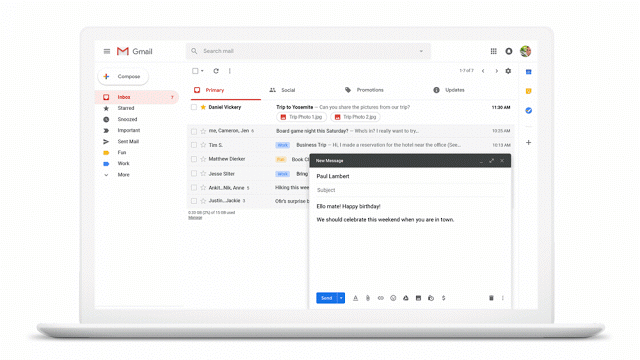Leading up to Gmail’s 15th birthday last year, Google added a lot of productivity and machine learning tools to its email service. (It may also have been trying to make up for the disappearance of its Inbox email app, but that’s an argument for another day.) Additions included a way for Gmail to write email subject lines for you and schedule an email to send at a later time.
It can be a little confusing to navigate some of Gmail’s features. In this tutorial, we’re going to focus on Gmail’s auto-completion tools Smart Reply and Smart Compose, which are designed to save time.
Letting a machine help write emails and subject lines for you can feel a bit unusual, but if you’re open to at least trying it out for yourself, here are the ways to automate your Gmail responses.
Enabling Smart Reply and Smart Compose
To allow Gmail to generate responses and email text, you first have to opt in from your Settings menu. If you are a regular Gmail user (instead of G Suite enterprise edition), here’s what to do:
On desktop
- Click on the gear icon on the upper right side and find the Settings page.
- Scroll down to the separate Smart Reply and Smart Compose options and choose “On” for either or both to enable the automated suggestions.
- You can also choose to allow Gmail’s machine learning to personalize the suggestions based on the way you write your emails by choosing “Smart Compose personalization.” For example, if you greet your colleagues with “Hi, team” versus “Hello, everyone,” it will automatically drop in whatever you use most often.
:no_upscale()/cdn.vox-cdn.com/uploads/chorus_asset/file/16010992/smart_compose_setting.png)
If you use G Suite, you may notice that the option to toggle on Smart Compose is not available. Your G Suite admin must enable this for the organization, so contact the person in charge if you’d like to test this out at work.
On the Android or iOS app
- Tap the hamburger icon on the upper-left side to open the side drawer. Scroll down to Settings.
- Select the Gmail account you want to address
- Tap the checkbox on Smart Reply and / or Smart Compose to toggle the mode on
Once the settings are turned on, your Gmail is set up to suggest replies and help auto-finish sentences based on your writing style.
What it looks like
Basically, you just start typing, and Gmail will begin suggesting words that might fit the sentence you’re writing.
Be aware that it won’t always come on for every email you write. Because Gmail needs context, you’ll likely find Smart Compose chiming in when you’re responding to an email or if you’re starting emails with some generic statements like “Nice to meet you” or “Hope you’re well.” If Gmail has a suggestion, an opaque set of text will appear next to what you’re typing.
On the desktop version of Gmail, you can press Tab to accept the suggestion. On the mobile app, if a suggested word or phrase appears, swipe right to add it to the email.

Smart Compose can also suggest email subjects. Leave the subject line blank, and start writing your email. Once you go back to fill out the subject line, Gmail will offer a suggestion that you can accept by pressing Tab on the desktop app or swipe right on mobile.
Smart Reply for canned responses
Smart Reply works a little faster than Smart Compose. Instead of suggesting words or short phrases for you, Gmail will offer three responses that might suit the email you’ve received. For example, if you’ve gotten an email reminding you of an appointment, Smart Reply may suggest responses like “Confirmed,” “Thanks,” or “I can’t make it.”
Tapping these responses will not send the email right away. You can add more text to the suggested answer before choosing to send it.
:no_upscale()/cdn.vox-cdn.com/uploads/chorus_asset/file/16011009/Screen_Shot_2019_04_05_at_1.46.23_PM.png)
If you are in an email conversation with several people, be aware that responding with a Smart Reply will CC everyone on that email. You’ll have to manually remove the people you don’t want in that response, so it’s best to only choose Smart Reply for emails you mean to send to everyone in the thread.
Should you actually use it?
Choosing to let a machine write your emails may feel impersonal, but it’s not designed to write the whole email for you. Smart Compose and Smart Reply work best when you use them to add filler sentences or quickly respond to yes or no emails. Plus, Gmail has gotten a lot better at suggesting responses that will make sense 90 percent of the time. (In my experience, the responses tend to veer toward affirmative answers, so they may not work best if you’re less prone to agreeing to everything.)
Besides, if you give this a go and find that you’d rather type your own answers, just go back to Settings and toggle those features off.
Update July 6th, 2020, 5:10PM ET: This article was originally published on April 5th, 2019; the introduction and the directions for using Smart Replay and Smart Compose have been updated
"smart" - Google News
July 07, 2020 at 04:55AM
https://ift.tt/2Z30Bqj
How to enable and use Gmail’s Smart Reply and Smart Compose tools - The Verge
"smart" - Google News
https://ift.tt/2P2kUhG
https://ift.tt/3febf3M
Bagikan Berita Ini















0 Response to "How to enable and use Gmail’s Smart Reply and Smart Compose tools - The Verge"
Post a Comment